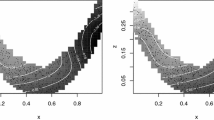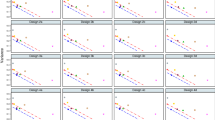Abstract
Smoothing splines are an attractive method for scatterplot smoothing. The SiZer approach to statistical inference is adapted to this smoothing method, named SiZerSS. This allows quick and sure inference as to “which features in the smooth are really there” as opposed to “which are due to sampling artifacts”, when using smoothing splines for data analysis. Applications of SiZerSS to mode, linearity, quadraticity and monotonicity tests are illustrated using a real data example. Some small scale simulations are presented to demonstrate that the SiZerSS and the SiZerLL (the original local linear version of SiZer) often give similar performance in exploring data structure but they can not replace each other completely.










Similar content being viewed by others
References
Chaudhuri, P. and Marron, J. S. (1999), SiZer for exploration of structure in curves, Journal of the American Statistical Association, 94, 807–823.
Eubank, R. L. (2000), Nonparametric Regression and Spline Smoothing, Marcel Dekker, New York.
Fan, J. and Gijbels, I. (1996), Local Polynomial Modelling and Its Applications, Chapman and Hall, London.
Fan, J. and Marron, J. S. (1994), Fast implementations of nonparametric curve estimators, Journal of Computational and Graphical Statistics, 3, 35–56.
Green, P. J. and Silverman, B. W. (1994), Nonparametric Regression and Generalized Linear Models, Chapman and Hall, London.
Härdle, W. (1990), Applied Nonparametric Regression, Cambridge University Press, Boston.
Hastie, T.J. and Tibshirani, R. J. (1990), Generalized Additive Models, Chapman and Hall, London.
Loader, C. (1999), Local Regression and Likelihood, Springer Verlag, Berlin.
Marron, J. S. (1996), A personal view of smoothing and statistics, in Statistical Theory and Computational Aspects of Smoothing, eds. W. Härdie and M. Schimek, 1–9 (with discussion, and rejoinder 103–112).
Silverman, B. W. (1984), Spline smoothing: the equivalent kernel method. Ann. Statist., 12, 898–916.
Wahba, G. (1991), Spline Models for Observational Data, SIAM, Philadelphia.
Wand, M. P. and Jones, M. C. (1995), Kernel Smoothing, Chapman and Hall, London.
Author information
Authors and Affiliations
Additional information
Marron’s research was supported by the Dept. of Stat. and Appl. Prob., National Univ. of Singapore, and by the National Science Foundation Grant DMS-9971649. Zhang’s research was supported by the National Univ. of Singapore Academic Research grant R-155-000-023-112. The Editor, the Associate Editor, and the referees are appreciated for their invaluable comments and suggestions that help improve the article significantly.
Appendix: Derivations of (5),(6), and (7)
Appendix: Derivations of (5),(6), and (7)
First of all, assume X1, X2, ⋯, Xn have been sorted so that X1 < X2 < ⋯ < Xn. Write fi = f(Xi) and γi = f″(Xi) to be the values of f(x) and f″(x) at Xi for i = 1, 2, ⋯, n. Define f = (f1, ⋯, fn)T and γ = (γ2, ⋯, γn −1)T. Let hi = Xi+ 1 − Xi, i = 1, 2, ⋯, n − 1. Let Q : n × (n − 2), R: (n − 2) × (n − 2) and K: n × n be the matrices as defined in Green and Silverman (1994, pages 12–13). According to Theorem 2.1 of Green and Silverman (1994, page 13), f is a natural cubic spline with knots at Xi, i = 1, 2, ⋯, n if and only if
Simple calculation then leads to the following desired formula:
with the weight matrix W = diag(w1, w2, ⋯, wn), the hat matrix Aλ = (W + λK)−1 W, and the response vector Y = (Y1, Y2, ⋯, Yn)T.
Using (11) and (12), we are now ready to give the matrix formulas for computing \(\hat{f}_{\lambda}(x), \hat{f}_{\lambda}^{\prime}(x)\), and \(\widehat{sd}\left\{\hat{f}_{\lambda}^{\prime}(x)\right\}\) at a given grid of locations x = [x1, x2, ⋯, xN]T. By Green and Silverman (1994, pages 22–23), for any x, we can write \(\hat{f}(x)\) and \(\hat{f}{}^{\prime}(x)\) as linear combinations of \(\hat{\mathbf{f}}\) and \(\hat{\gamma}\). Let hi(x) = x − Xi, i = 1, 2, ⋯, n. When x < X1,
When Xi ≤ x ≤ Xi+ 1, let \(\delta_{i}(x)=[1+\frac{h_{i}(x)}{h_{i}}] \hat{\gamma}_{i+1}+[1-\frac{h_{i+1}(x)}{h_{i}}] \hat{\gamma}_{i}\) for some i = 1, 2, ⋯, n,
When x > Xn,
It follows that \(\hat{f}(x)\) and \(\hat{f}^{\prime}(x)\) can be written respectively as \(c^{T} \hat{\mathbf{f}}-d^{T} \hat{\gamma}\) and \(\tilde{c}^{T} \hat{\mathbf{f}}-\tilde{d}^{T} \hat{\gamma}\) where \(c, \tilde{c}, d\)and \(\tilde{d}\) are coefficient vectors, depending on x and X1, X2, ⋯, Xn only. Let \(\hat{f}\left(x_{i}\right)=c_{i}^{T} \hat{\mathbf{f}}-d_{i}^{T} \hat{\gamma}, \hat{f}^{\prime}\left(x_{i}\right)=\tilde{c}_{i}^{T} \hat{\mathbf{f}}-\tilde{d}_{i}^{T} \hat{\gamma}, i=1,2, \cdots, n\). Define C = (c1, c2, ⋯, cn)T, D = (d1, d2, ⋯, dn)T, and define \(\tilde{C}\) and \(\tilde{D}\) similarly. Set \(\hat{\mathbf{f}}_{\mathbf{x}}=[\hat{f}(x_{1}), \cdots, \hat{f}(x_{N})]^{T}\) and \(\hat{\mathbf{f}}_{\mathbf{x}}^{\prime}=[\hat{f}^{\prime}(x_{1}), \cdots, \hat{f}^{\prime}(x_{N})]^{T}\). Then, using (11) and (12), we have
where M = C − DR− 1QT and \(\tilde{M}\) is similarly defined.
Rights and permissions
About this article
Cite this article
Marron, J.S., Zhang, J.T. SiZer for smoothing splines. Computational Statistics 20, 481–502 (2005). https://doi.org/10.1007/BF02741310
Published:
Issue Date:
DOI: https://doi.org/10.1007/BF02741310




